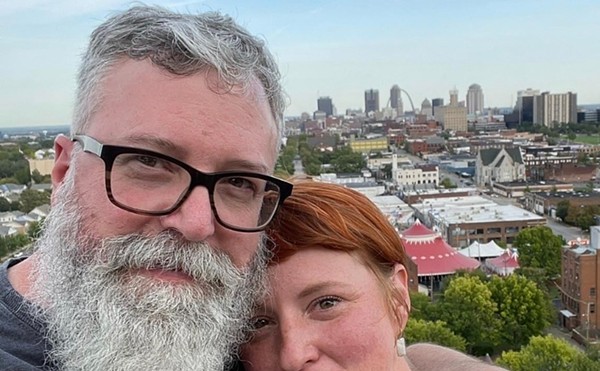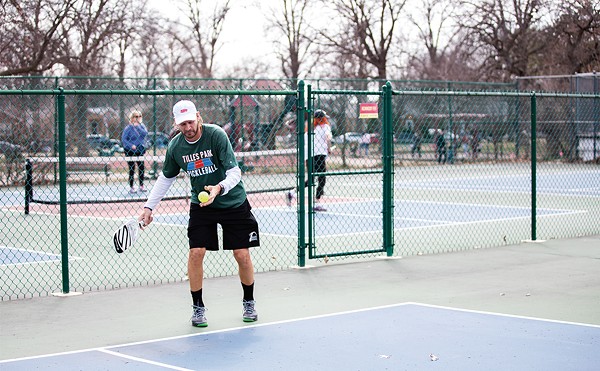Besides, if you're America's greatest living choreographer and 70 and focused on a new work (No. 115 in Taylor's lexicon), why the hell do you need to trouble yourself with yet another journalist?
But there he is, hunched over a short wall, smoking, casually attired in a rumpled long-sleeved white shirt and khakis, his graying hair looking as if it could have been cut at a barber college. Yet as affable as he appears, it's best to head to another corner of the parking lot and try to look as nonchalant as a hooker when the police cruiser passes.
The local publicist arrives as official escort, and seats are taken, out of everybody's way, in the Fox auditorium. Taylor is centerstage amid his company, looking bemused among these young, vital, ambitious dancers. His head perpetually cocked at an angle, as if in abstracted observance, he talks quietly, one hand gracefully settled on his hip while the other gestures reservedly from the wrist. Centerstage looks to be a comfortable place for him, a space given to him (and taken by him) since he danced for the mythic Martha Graham in the 1950s. (He records in his irreverent yet substantive autobiography, Private Domain, that when the "mighty Martha" first saw him in a class, she pointed and said, "I want him.") He's a stage presence, phantomlike in these later years but no less a presence.
Bliss remembers meeting Taylor when he joined her in the ballet classes of the indomitable Anthony Tudor in the early 1960s. "Lord, he was good!" she exclaims.
The Graham dancer's entry into Tudor's rigorous ballet instruction was typical of his spirit, says Bliss. "Of course, you have to understand he was a maverick. He was doing something very unusual. When I danced, you see, there was no relationship between ballet with modern and modern with ballet."
Taylor changed that, bringing a different presence to the stage with his football player's physique and irreverent disregard for the prescribed boundaries. Twyla Tharp and David Parsons are just two dancer/choreographers who emerged from his company to further explore the frontier Taylor opened.
Today, the 2001 version of the Paul Taylor Dance Company is attired in stylish flapper and vaudevillian Depression-era garb. One, Sylvia Nevjinsky, a Portuguese dancer with a Hunter College psychology degree, sports a prominent stage-prop pregnancy bulge. She goes over a complex combination, stretches, poses. She's a sprightly pregnant woman, snapping her fingers saucily at the full extension of her arms.
The run-through of "Black Tuesday" begins, with Taylor taking a seat in the center of the house, somehow effecting an air of both anonymity and imperiousness. "Black Tuesday," with a gorgeous set and costume design by Santo Loquasto and lighting by Jennifer Tipton -- longtime collaborators with Taylor -- begins like a cartoon version of the Roaring '20s, with an old soft-shoe, a couple of romantic duets (with a jazzier flair than what Astaire and Rogers would have danced) and the bulging Nevjinsky high-kicking it to uproarious effect in her solo to "Slummin' on Park Avenue." Typical of Taylor, the pregnant woman gets the liveliest steps.
Each of "Black Tuesday"'s individual parts is accompanied by a Depression-era popular song, optimistic numbers made to buck up (and sell to) the despairing masses. A film such as Top Hat, for example, portraying the worries of the glamorous elite, is made during the depths of the Depression and thus embedded with irony. The exuberance of Taylor's light-muscled dancers reflects this ironic theme, but the cartoon dissolves as the strains of "The Boulevard of Broken Dreams" begin. Annmaria Mazzini stands stage right in fractured light, dressed in a tight brown cleavage-exposing outfit, approximating a sultry pose and swagger. Suddenly she's physically brought down, on all fours, rolling on her sides and back as if pulled to the ground and shaken violently -- by gravity, by the gods, by the great bear that tore apart the rich dreams of Wall Street and America.
A gang of men enter forcefully, and what happens to her is as horrifying, as gripping, as seeing Gloucester's eyes gouged out in King Lear. Mazzini is tossed about from man to man (Taylor turning the conventions of showy dance numbers to reveal an inherent misogyny). Then she is surrounded by them, carried by them, then turned upside down, her legs sticking in the air like twin racks of meat.
It is terrible. She is as quickly abandoned by the men as she was set upon by them. She attempts a retreat into a dignified pose and is just as suddenly thrown down by them again, disregarded again. Taylor generously gives her, and the audience, a bit of ballast. Principal dancer Patrick Corbin enters, in doughboy garb, to help Mazzini to her feet and a strong exit from the stage.
Dance St. Louis' Bliss (the presenting organization co-commissioned "Black Tuesday," with the American Ballet Theater and Johnson County Community College, its first such commission) identifies one of the signatures of Taylor's choreography as "When you are in the middle of a great emotional moment, both musically and choreographically, he all of a sudden does something that is so humorous, and you go 'Wait a minute. What have I seen?'"
After Mazzini's assault, the diminutive powerhouse Lisa Viola comes onstage, and, reminiscent of Taylor's characters in his popular "Funny Papers," dances a murderous jig to the tune of "I Went Hunting and the Big Bad Wolf Was Dead." The piece shifts toward its conclusion, with Corbin plaintively performing graceful turns and falls and arcs to "Brother, Can You Spare a Dime?" -- the whole company with hands outstretched into a thin bank of light at the finale.
In a full-dress rehearsal, with no audience to roar its applause, the sounds of the dancers -- sighs of exhaustion, their huffing breath -- are heard throughout the theater. Dancers make their efforts look effortless, but these are workers, hard workers, and Taylor is gentle with them. He lifts himself onto the Fox stage admirably for a 70-year-old dancer whose body has suffered the ravages of his art. He's centerstage again, showing Corbin how to keep his leg straight on a backward roll, working with the elegant Maureen Mansfield on a combination of steps.
When he drops from the stage, his landing is undancerly leaden. He heads outside for a cigarette before the company runs through "Black Tuesday" once again. He turns and responds to a question with a lilting will-o'-the-wisp voice.
That night, after a preshow talk and the performance itself, Taylor sits in a patio chair at the home of a St. Louis art patron, displaying a walruslike diffidence toward all of those approaching him with words of praise at the exclusive party.
"I'm really very tired," he confides when a moment is set aside for an informal interview. He rarely travels with the company anymore: "I was on the road for 20 years."
Taylor appreciates comments about "Black Tuesday" and says he liked it fine but notes, "I've seen it so many times."
He gratefully accepts a bottle of Bud from a colleague. Taylor admits that he misses the old battle lines between modern dance and neoclassical ballet. "I try to get it riled up again by saying certain things," he says mischievously, but no one seems to be taking up the provocation. When he grins, the smile lines near his eyes are deep.
In temperament and character he is far from the grandiose personalities that were Graham and José Limón, but he misses their drama: "They were so theatrical. They were theater people, and I love theater people."
More guests hover, waiting to meet him. America's greatest living choreographer tries inconspicuously to light another cigarette.





